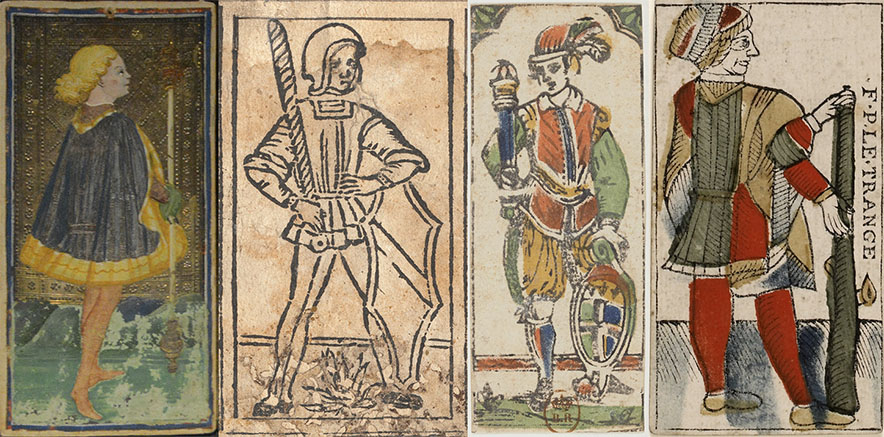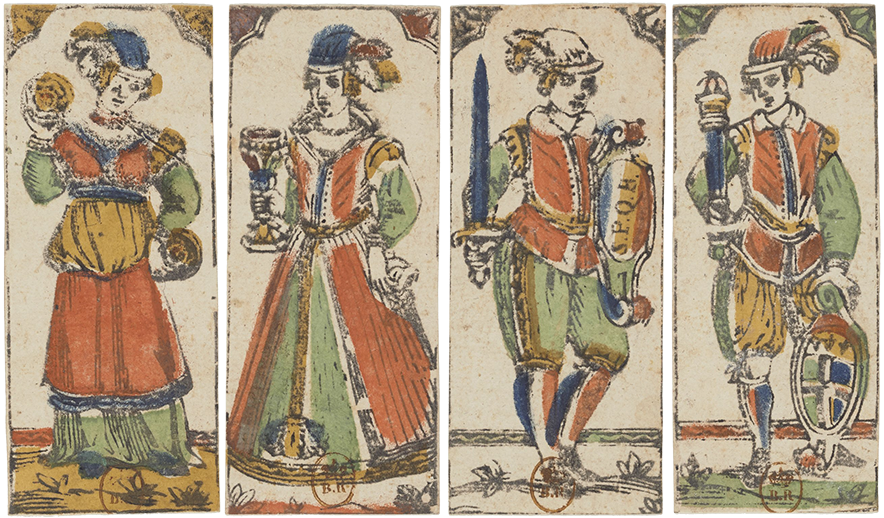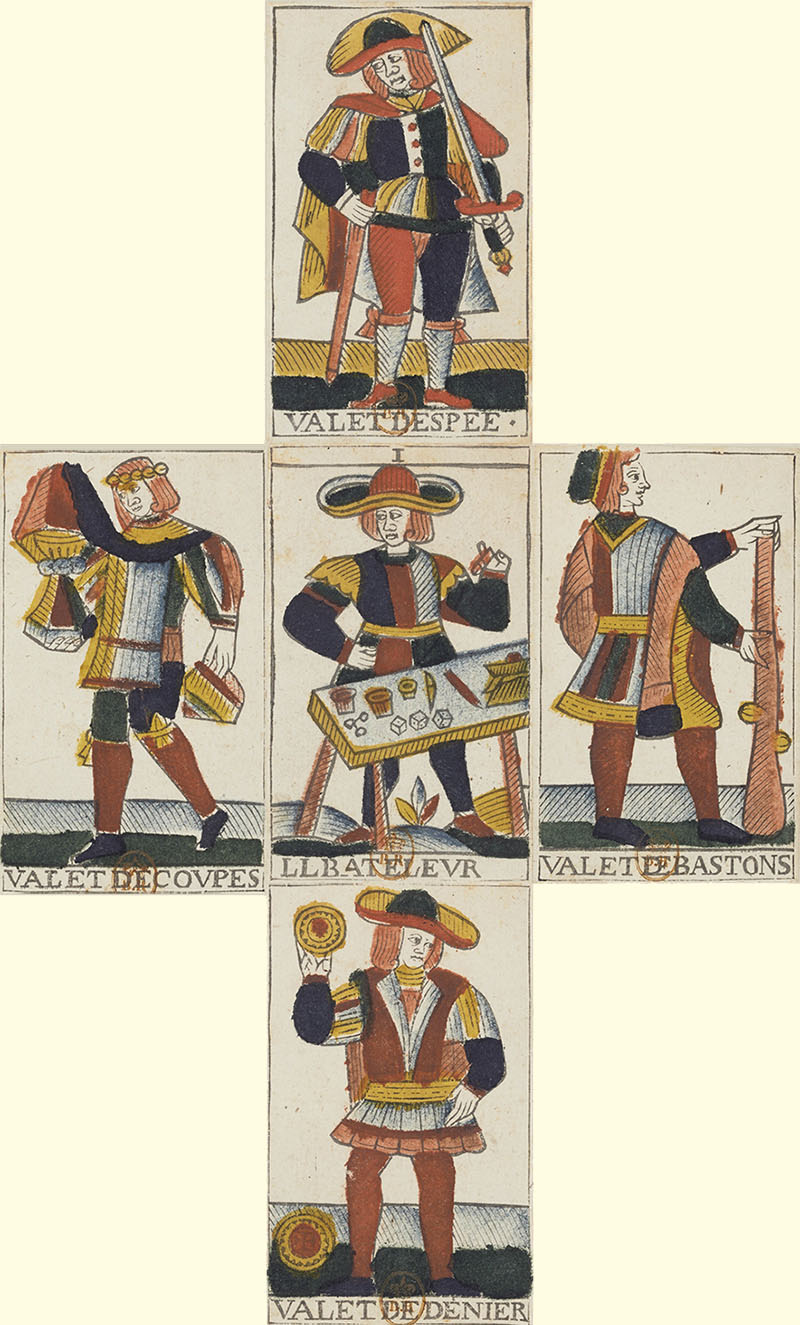THE TAROT WHEEL
THE PAGES
The first and lowest character in the Tarot court is the Page. Like all the court symbols, when appearing in a spread, the Page indicates a person in real life. In general, the Page stands for a young person, not yet at the age of maturity. More indications about whom this person is, are given by the suit symbol. When we are dealing with Pages, the suit symbol indicates potential characteristics, they are nor fixed yet.
Page of Coins - Pages are associated with Coins, the suit that deals with yourself. This card represents the Earth aspects within the element Earth. After the Ace, representing the element Earth in all its splendor, it is the Page of Coins that is closest to the element Earth. The card represents its most inner characteristics. The Page of Coins is a young person very busy with himself, who has very little eye for the external world around him. He does not need to have many friends, typical one or two are more than sufficient. He is occupied with his own future and with improving himself. The Page of Coins is an independent person, maybe a born businessman or a future farmer laboring his own fields.
Page of Cups - The Page of Cups is a young person who is emotional and who loves to have friends. Stronger, he needs to have friends, and he needs to be appreciated by his friends. He is always willing to share everything he has. For him, the relational bonds with other people are the most important thing in the world. The Page of Cups might be the happiest person there is, when working, (even as a volunteer) in the social sector. He might also be very interested in medicine, healing other people.
Page of Swords - The Page of Swords stands for a young person seeking for knowledge. He might be a very devoted student, mostly he is doing well at school. This knowledge he is looking for will help him to understand the world and to learn the facts. He (or she) is the kind of child that parents are proud of, giving no problems and doing their best at school. The Page of Swords is a typical student, and his future might be in education, or why not, in justice.
Page of Batons - The Page of Batons is a very dominating young person. You will always see him with a group of friends around him, and he is their leader. For him, the benefit of the group prevails over the benefit of one person. He is a member of several associations and often part of the board. The Page of Batons is a born politician and future leader of society.
Traditionally, a Page is displayed as a boy or a young man who serves at the court, or who serves a knight. On the previous pages, I stated that the court cards can have some additional information about the structure of the Tarot deck. But where can we find this information? Let us have a look at some Page of Batons cards.
From left to right we see the Page of Batons of the Visconti Sforza deck (+1451/54) from Milan, the Rosenwald sheet from Bologna (+1500), the Tarocchi da Bologna (+1600 and the Tarot of Marseille made by Jean Dodal (+1701) in Lyon. On the four cards a boy or a young man holding a baton in his hand. On the first and the last card we see the Page in profile, on the two other decks we see him almost from the front. Four very similar images and, in my opinion, no extra information can be derived from these cards. Apparently, this is not the way to proceed. Instead of looking to the same Page in different decks, let us have a look at the four Pages of a same deck. As an example, I use the Tarocchi da Bologna, created around 1600 and conserved in the French National Library.
Here we see something very interesting. The Pages of Coins and Cups are female and the Pages of Swords and Batons are male. This confirms our earlier conclusion that Coins and Cups have female and Swords and Batons male characteristics. The Tarocchi da Bologna was not the only deck who used this principle, we find it also on the Budapest sheets, on the Rosenwald sheets and on the Minchiate deck. All these decks were created in the region around Bologna and Florence. However, it is not a characteristic for all decks from this region, the Tarocchini of Giuseppe Mitelli for example, also created in Bologna, has only male Pages.
The French decks used the Pages in a complete different way to give some information about the structure of the Tarot deck. Have a look at the next figure, that is derived from the Tarot of Jean Noblet, created around 1657 in Paris. For the ease of understanding, we put the Conjurer (le Bateleur) in the center of the figure.
Now, there is a wealth of information describing the association between the suit symbols and the elements, not existing on the separate Page cards. On the vertical axe, we have three young men standing in the same posture, the left food pointing to the left and the right foot pointing to the right. The hair and hat of the three boys are identical, same model, color and length of hair and same model of the hat. The other two boys are of the same age and have also the same model and color of hair. Only their hat and posture is different. The boy at left is walking to the left, the Page of Cups, and the boy at right, the Page of Batons, is facing the right. The association of the Suits with the elements is clear through the position of the different pages. Coins are associated with Earth, Cups with Water, Swords with Air and Batons with the energy of Life. Because Life it is, the Club of the Page of Batons is burgeoning and has two easily identifiable buds.
The Pages and the Conjurer have much in common. The main difference is that the Pages indicate particular persons, while the Conjurer, not limited by a suit symbol, expresses the promise of Youth. I will not try to identify other particularities of this specific deck, while here we are dealing with the Pages in general and not with the characteristics of a single deck. All Tarot of Marseille decks and their regional versions have the same characteristics, although sometimes mirrored (Vievil and its derivates like the Belgian Tarot).




